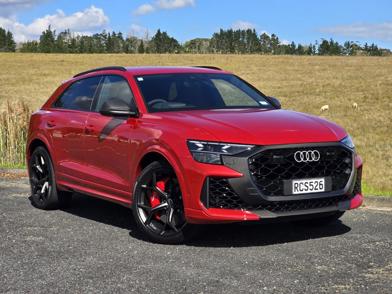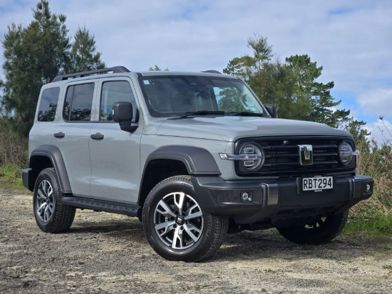Remember when 10-12l/100km was perfectly acceptable fuel consumption for a medium-sized family car? It’s amazing to think how quickly expectations have changed: if a new car isn’t achieving half that, there’s a problem.

Engines and transmissions have become more efficient over the decades of course, but it’s electrification that’s really driving improved fuel efficiency now. The future might be pure-electric, but at the moment many carmakers are trying every hybrid trick in the book to help combustion engines clean up and drink less.
Which brings us to the Honda ZR-V Sport, a small-medium SUV that has a very complex hybrid powertrain that proved very effective during our test time.

What’ll she do? We tried three self-contained exercises with the ZR-V: a 30km crawl around Auckland city in rush hour (a loop from the North Shore towards West Auckland), a familiar spirited handling route (about 100km) and another gentle motorway run up the new Ara Tuhono highway towards Warkworth (another 100km return).
At the moment many carmakers are trying every hybrid trick in the book to help combustion engines clean up and drink less.
On the urban crawl the ZR-V averaged a remarkable 4.7l/100km, making maximum use of electric drive, regenerating quickly and often. On the, shall we say, “performance” loop, 5.7l/100km. And on the motorway run, 5.5l/100km – remarkably consistent across very different driving environments. Which we’ve found tends to go hand-in-hand with great hybrid technology (by which we mean Toyota).

And how does she do it? Well, the Honda’s e:HEV hybrid system is nothing like a Toyota. Essentially, it’s a range extender: there’s a 2.0-litre petrol engine that mainly acts as a generator, producing electricity for a small battery and electric motors that drive the wheels. It’s actually a bit more complicated than that, but that’s the gist.
Shame Honda has abandoned its clever Magic Seat back-seat folding configuration; it’s still in the Jazz.
In fact, it’s very similar to the powertrain in the Jazz e:HEV, but the ZR-V ha a larger engine/generator and a different gearbox: continuously variable compared to the Jazz’s dual-clutch. For those reasons (or others we possibly don’t understand), the ZR-V delivers even more consistent economy than its smaller sibling. Not better, because the Jazz can be incredibly frugal; just more consistent.

And as with Jazz, you really don’t need to think about it. Just drive and let the powertrain management work everything out.
The power and torque numbers aren’t huge, but this is a smooth and strong powertrain – as long as you remember the soundtrack from the petrol engine doesn’t always fit the driving circumstance, firing up to make electricity rather than drive the wheels.

Although Honda has gone to some lengths to make ZR-V a more pleasing aural experience at speed. Press on a bit harder and the gearbox does a really good “stepped” impression of a conventional automatic. Which is completely unnecessary when you think about it, but nice all the same.
The ZR-V cabin borrows quite a bit from Civic – so it’s classy, modern and generations ahead of the now-defunct HR-V and current CR-V (soon to be replaced). All-digital instrumentation of course, but colourful, clear and intuitive – including a green “EV” indicator that lights up when you’re on pure electric power and a battery indicator that shows you the state of charge. It’s a small battery (1.05kWh), so it depletes quickly – but regenerates equally fast, as you coast or brake.

You can actually adjust the level of regen/braking with the steering wheel paddles. They’re metal, too; nice.
Phone projection is wireless for Apple but cabled for Android (boo); the gear selector on the e:HEV is a slightly strange collection of buttons with a big one for Drive but a small switch for Reverse. Takes a bit of getting used to, especially when you’re doing three-point turns.

As a family SUV, this is truly polished and modern. The front seats are fantastic, the rears spacious (the wheelbase is almost as long as the current CR-V). Shame Honda has abandoned its clever Magic Seat back-seat folding configuration, though; it’s still in the Jazz.
ZR-V has live services (a first for Honda NZ) and a bunch of surprise-and-delight features, including “reservation” locking – you can lock the driver’s door while others are still open, and walk away. When the other occupants close theirs and/or the tailgate, the whole car then locks.

The e:HEV Sport is $8k more expensive than the petrol-turbo, but it’s much more sophisticated and we still reckon it’s a better drive. And it’s much higher-spec, with the likes of full leather, upgraded audio and full 360-degree camera.
Extended time in the ZR-V has reinforced our impression that this is a massive leap into the future for Honda’s SUVs – and finally, a true rival for those clever Toyota hybrids. It also bodes incredibly well for the larger next-generation CR-V, due here this year.
(ICYMI, first published July 21)
HONDA ZR-V SPORT
ENGINE: 2.0-litre petrol four with e:HEV hybrid system, dual electric motors
POWER: 135kW/315Nm
GEARBOX: e-CVT, FWD
CONSUMPTION: 5.5l/100km (WLTP)
PRICE: $55,000















